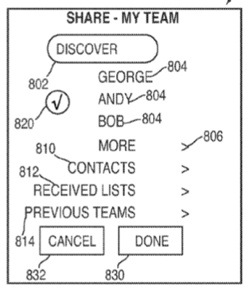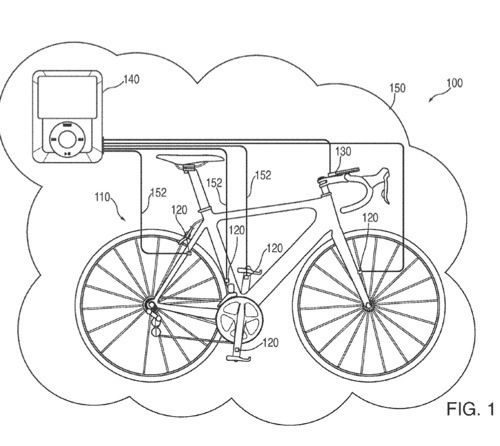A new Apple patent (number 20100198453) has appeared at the US Patent & Trademark Office and involves integrating a portable device with a bicycle. The electronic device can receive the output from sensors coupled to the bicycle and generate riding characteristics for display to the user.
The electronic device can in addition receive communications from other electronic devices and provide the communications to the user. In some embodiments, the electronic device can be paired with the devices of one or more other cyclists so that the cyclists can share riding characteristics and other information. This can allow the cyclists to ride as a team and better assist each other. The inventors are Jesse L. Dorogusker, Anthony Fadell, Andrew Hodge, Allen P. Haughay, Scott Krueger, James Eric Mason, Donald J. Novotney, Emily Clark Schubert, Policarpo Wood and Timothy Johnson.
Here's Apple's summary of the invention: "Many bicyclists desire accessing different information as they ride, such as speed, position, heart rate, power or other information related to components of the bicycle. To provide such information to the cyclist during the ride, a bicycle computer can be coupled to the bicycle, for example on handlebars. The bicycle computer can be connected, using wires or wirelessly, to one or more sensors embedded within the bicycle or in bicycle components. The bicycle computer can receive sensor information and display metrics related to the sensor information on a display for the user. The displayed information can be updated at any suitable interval, for example determined based on power considerations, sensor refresh rates, user requests for particular information, or any other suitable interval.
"Bicycle computers, however, are typically expensive components that would not be purchased by casual or semi-serious bicyclists. Many bicycle computers require extensive set-up to connect the bicycle computer to various sensors embedded on the bicycle, for example by requiring a complex wireless pairing procedure or by connecting several wires to the computer. In addition, many bicycle computers only provide information for the bicycle with which the computer is coupled. The bicycle computer can not share information related to the bicycle with which it is coupled with other computers, or can alternatively only provide information related to a ride once the ride is completed and the computer is connected to a host device (e.g., a desktop or laptop computer) that sends the information to a remote server for processing and display.
"In some embodiments, a system for communicating riding characteristics among a plurality of bicycles can be provided. The system can include a first electronic device coupled to a first bicycle. The first electronic device can determine riding characteristics, other than location, of the first bicycle. The system can also include a second electronic device coupled to a second bicycle. The second electronic device can be operative to determine at least one riding characteristic of the second bicycle, receive in real-time from the first electronic device the determined riding characteristics of the first bicycle, and provide the determined and received riding characteristics to a display associated with the second electronic device.
"In some embodiments, an electronic device for providing cycling information to the users of several bicycles riding in a group can be provided. The electronic device can be associated with a first bicycle, and include control circuitry operative to detect several electronic devices associated with the several bicycles. The control circuitry can be operative to determine at least one riding characteristic of the first bicycle, and receive, in real-time from each of the detected several electronic devices, at least one riding characteristic of each of the plurality of bicycles. Riding characteristic can include at least one of speed, distance, time, altitude, elevation, incline, decline, heart rate, power, derailleur setting, cadence, wind speed, path completed, expected future path, heart rate, power, and pace.
"In some embodiments, a sensor for use with an electronic device can be provided. The sensor can be coupled to a bicycle and include communications circuitry operative to pair with at least one authorized electronic device. The sensor can also include control circuitry operative to monitor the movement of at least one bicycle component, determine, from the monitored movement, that the bicycle is in use, detect that the communications circuitry has not received a communication from the at least one authorized electronic device, and generate an alert indicating that the bicycle is being used without authorization. The control circuitry can then direct the communications circuitry to broadcast the alert, for example to a remote server."














